
Typically, my travel/tourist routine is super basic. I get up, early have coffee, and hit the streets, alone, on foot (I walk everywhere unless time is an issue). Unless I have a destination planned, I don’t check a map (I do record my routes based on the photos I’ve taken). I usually get back to my hotel room/flat/whatever about 12:00 or 1:00, and then I’ll go out again with friends/family. I’m usually back from wherever by sundown and in bed fairly early to rest up for the next day. On this adventure, my dear friends joined me for the first part of the trek, so we set out in the afternoon.
I don’t know how long this particular walk took in total, as I tend to meander; however, this leg is only about ¾ of a mile, but it can be an exhausting 3/4 of a mile—especially in midsummer.
Tips: there’s nothing new to my suggestions, but they’re still valuable:
* The key is to be aware of when you’re in need of a break. If you can, be proactive and
sit at a café or on a shady bench before you really need to.
* Wear sunscreen. Wear a hat.
* Take along plenty of water. Much of the walk is without shade, and the Roman sun—as
well as its humidity–can be intense.
* Be aware that some of these areas get extremely crowded. Be wary of pickpockets.
I know this sounds like a pain, but the experience, and the things you encounter, make it completely worthwhile.
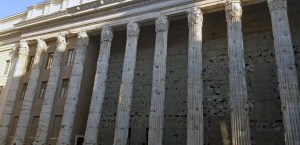
The last time I was in Rome, I was staying a few blocks away from the Pantheon; it was my first stop every morning (after I stopped somewhere for a cappuccino, anyway).
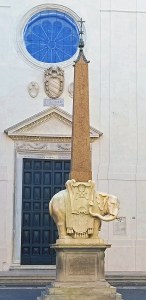
Take the road to the left of Pantheon—the Via della Minerva, which takes you past the Basilica di Sacra Maria Sopra Minerva. “sopra Minerva” means “over Minerva.” The church was built on the site of a temple to Isis. St. Catherine of Siena is buried here, as are Fra Angelico, numerous dignitaries, and several popes. A sculpted elephant with an obelisk stand in the piazza before the basilica. The statuary is from 1667; Bernini designed the elephant. The obelisk is Egyptian (it was discovered during excavations).
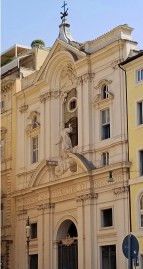
Continue down the street—it becomes Via dei Cestani then Largo delle Stimmate (passing Santissime Stimmate di San Francesco, the dramatic 18th century church pictured on the left).
Cross Corso Vittorio Emanuele II at the tabacchi.
On right, you’ll see the Largo di Torre Argentina,
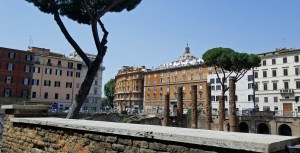
In 1927, during construction, workers discovered numerous ruins—temples, a theater, and a speaking house. While now it’s famous for its colony of feral cats, it happens to be the location of Julius Caesar’s assassination on 3/13/44 BC. That’s right. You might have assumed he was murdered in the Roman Forum, but he was attacked outside of Pompey’s Curia (its ruins are here, midway down the Via di S. Nicola de’ Cesarini). Adjoining the remains of the curia are what is left of the entrance to Pompey’s theater—the first permanent theater built in Roman (55 BC).

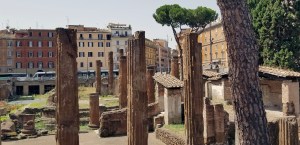
At Via delle Botteghe Oscure, take a left. On this stretch, you’ll pass the ruins of Tempio  delle Ninfe (Temple of the Nymphs), which was built in the 2nd or 3rd Century BC.
delle Ninfe (Temple of the Nymphs), which was built in the 2nd or 3rd Century BC.
You’ll also pass the Crypta Balbi, a museum built around the remains of a first century BC theater. Excavations of the structure are ongoing, and the museum gives you an opportunity to view how Rome changed between classical and medieval eras. Apparently, in the basement you can walk about the remains of the ancient theater itself).
A short while later, you arrive at Via San Marco; follow the curve of the street, and you’ll find yourself on Piazza Venezia and before the enormous, classically-inspired Victor Emmanuel II National Monument / Altare della Patria (altar of the fatherland), which celebrates the leader who led Italy’s unification—the Risorgimento–in the 19th century:

Cross over. You’re on the Capitoline—the center of ancient Rome.
Crossing over to the monument, go towards the left. You will see two grand stairways—one leads to Basilica of Santa Maria in Ara Coeli (Saint Mary in Heaven), one leads to a courtyard, the Piazza Comidiglia (designed by Michaelangelo), grand sculptures, and the Capitoline Museum.

Here, my friends and I parted, and I walked on through the Forum, the Via Sacra, Via San Gregorio, and proceeded to get lost.
Next post: the Forum, Roger Waters, and the Tiber. Also, I get lost.
Related:
Castel Sant’Angelo, Ponte Sant’Angelo

6 thoughts on “From the Pantheon to the Capitoline”